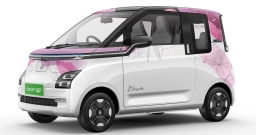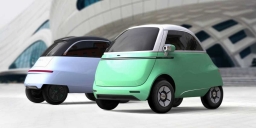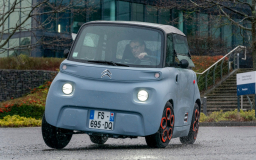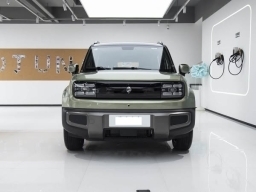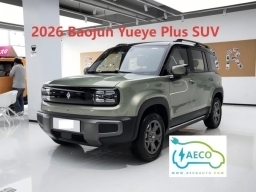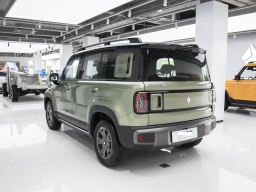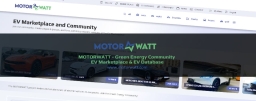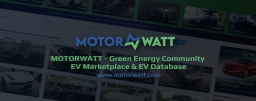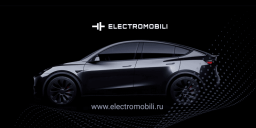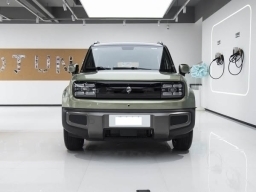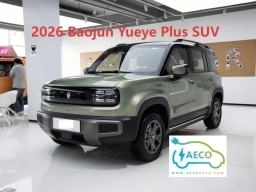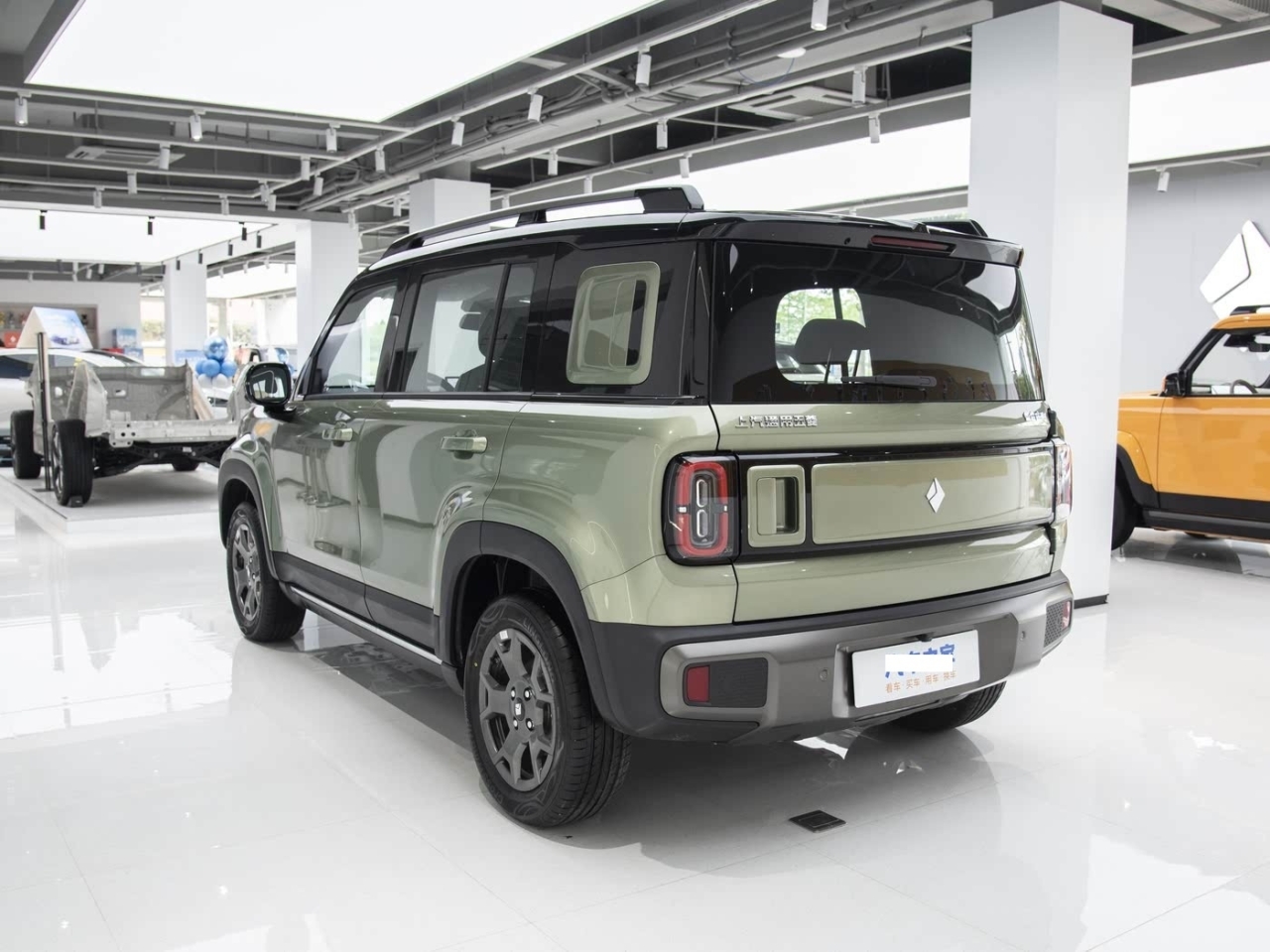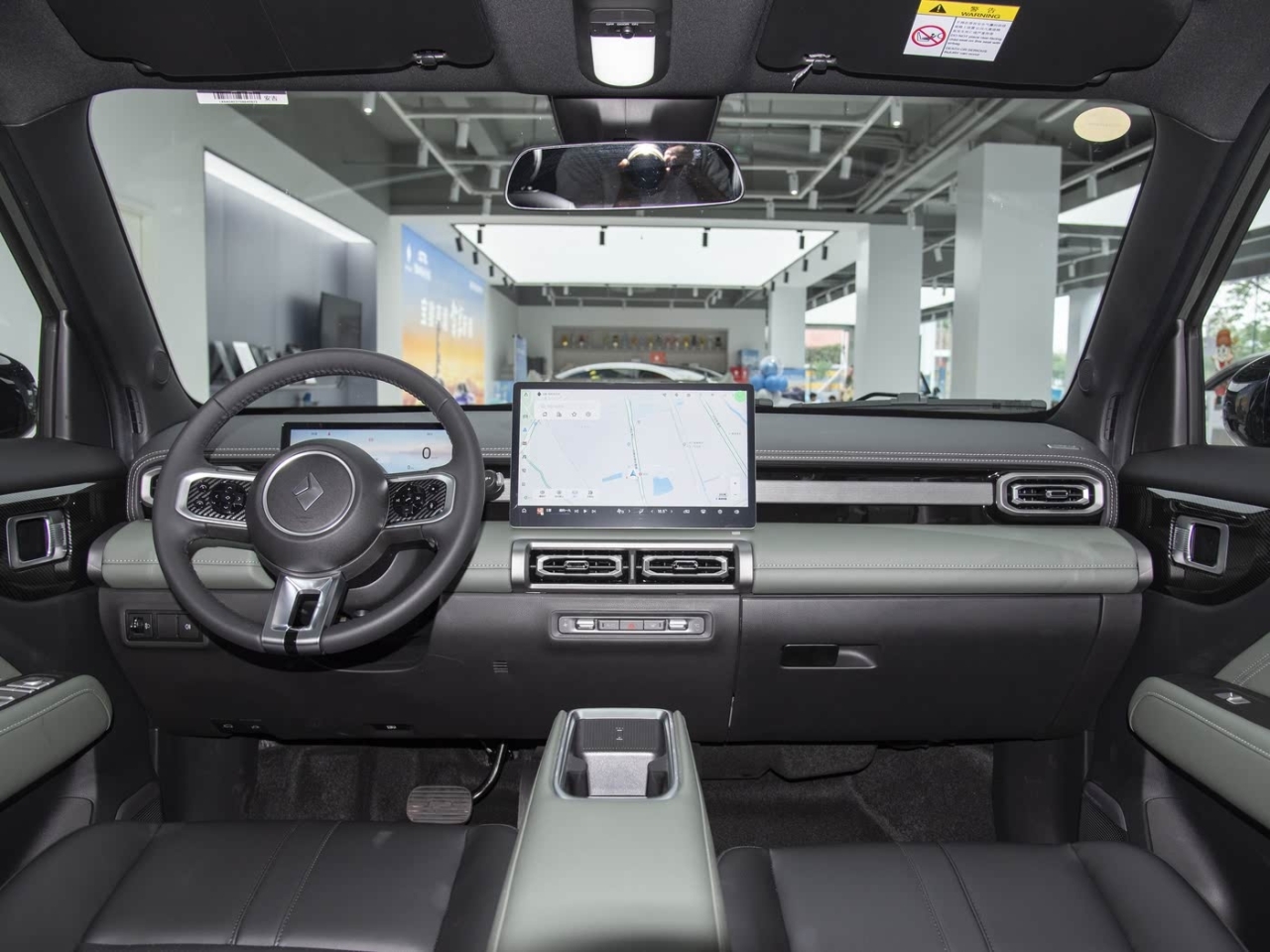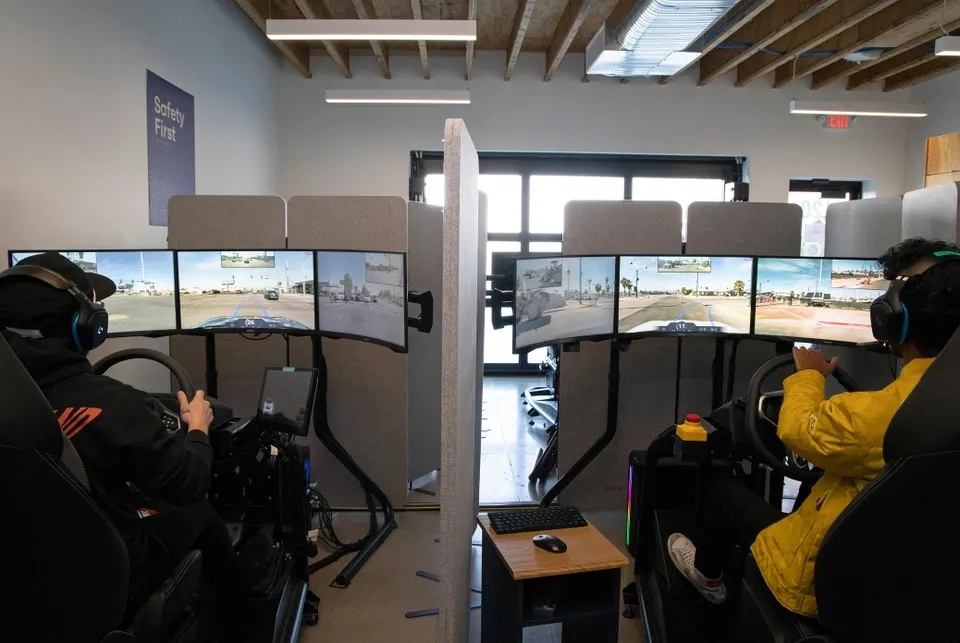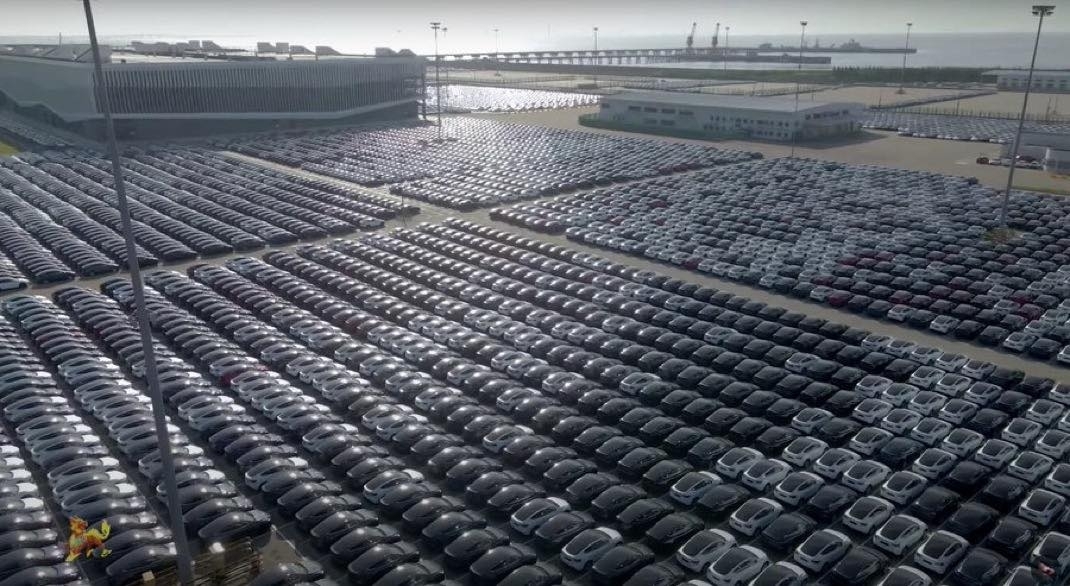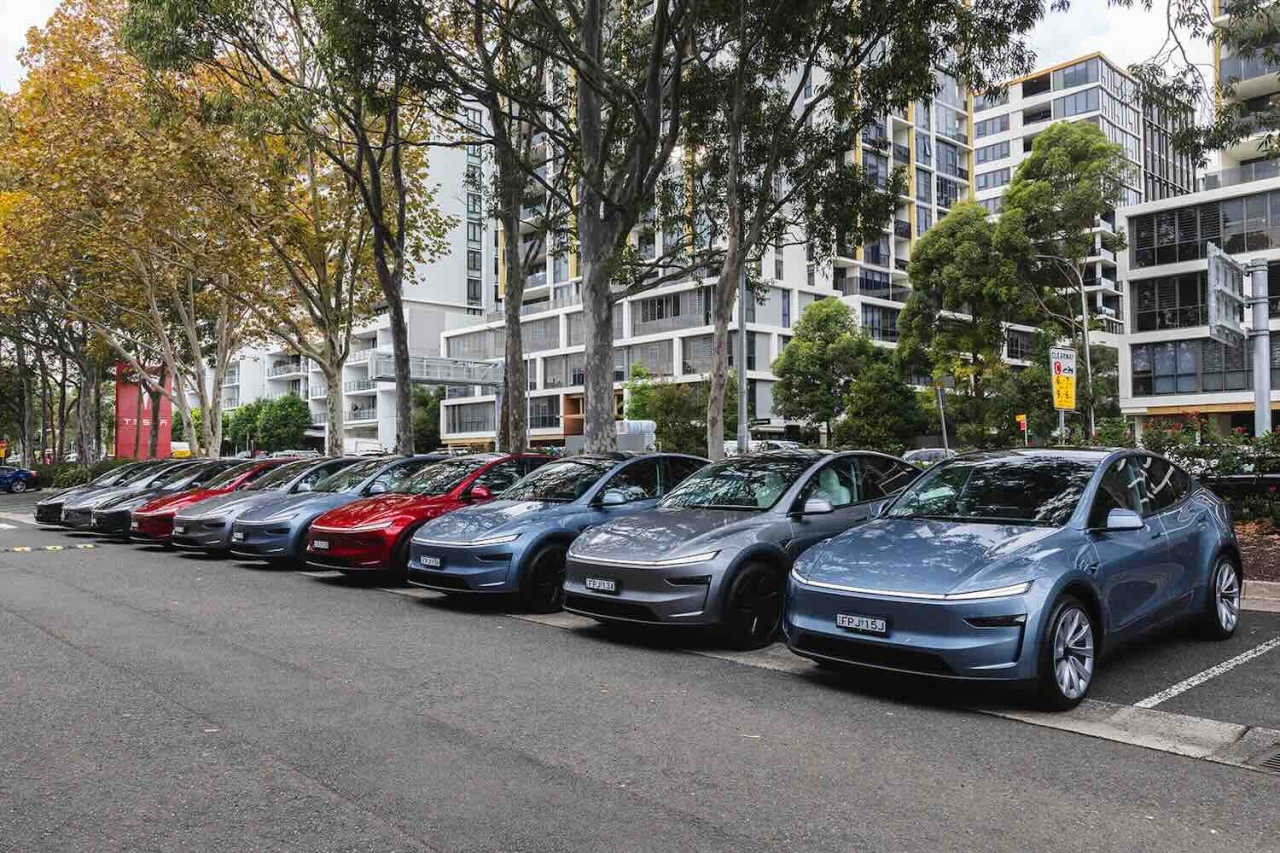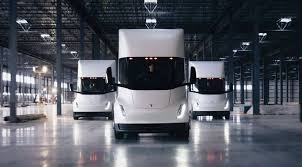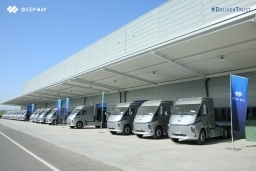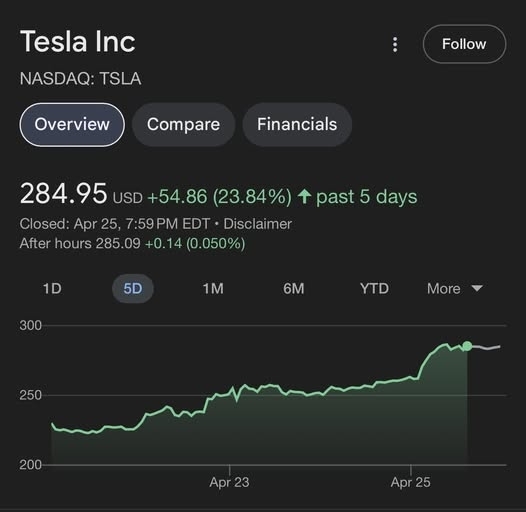- Joined 3 years ago
- 6 Achievements
-
The Onvo L90 electric crossover from Nio started presales in China for 193,900 yuan (27,000 USD) with the BaaS subscription applied. Brand’s officials claimed that it is the lightest full-size three-row SUV with a curb weight of 2,250 kg. The...The Onvo L90 electric crossover from Nio started presales in China for 193,900 yuan (27,000 USD) with the BaaS subscription applied. Brand’s officials claimed that it is the lightest full-size three-row SUV with a curb weight of 2,250 kg. The L90 boasts a 900V high-voltage system and a 4D mm-wave radar.More
https://ev.motorwatt.com/ev-database/database-electric-cars/nio-onvo-l90NIO ONVO L90 Price and Review - EV Databasehttps://ev.motorwatt.com/ev-database/database-electric-cars/nio-onvo-l90Discover the NIO ONVO L90—an electric 3-row SUV offering 605 km range, 85 kWh battery, AWD, 598 hp, and fast battery swaps. Starting at $30,300 (€28,270 / £24,130), it’s a high-tech family mover that delivers space, speed, and smart features at a compelling price.Post is under moderationStream item published successfully. Item will now be visible on your stream. -
The BYD B7 is a 6-meter electric mini coach bus from China with a 120 kWh LFP battery, 225 km (140 mi) range, and seating for up to 42 passengers. Launched in 2024, it supports fast charging and costs $97,000 (€90,210/£76,630).
https://ev.motorwa...The BYD B7 is a 6-meter electric mini coach bus from China with a 120 kWh LFP battery, 225 km (140 mi) range, and seating for up to 42 passengers. Launched in 2024, it supports fast charging and costs $97,000 (€90,210/£76,630).More
https://ev.motorwatt.com/ev-database/database-electric-buses/byd-b7BYD B7 Price and Review - EV Databasehttps://ev.motorwatt.com/ev-database/database-electric-buses/byd-b7Explore the BYD B7 electric mini coach bus with 225 km (140 mi) range, 120 kWh LFP battery, and flexible seating for up to 42 passengers. Starting at $97,000 (€90,210/£76,630), it's ideal for urban transit, schools, and shuttle fleets.Post is under moderationStream item published successfully. Item will now be visible on your stream. -
The 2025 Ford Mustang Mach-E is an all-electric SUV with AWD, a 91 kWh battery, 435 km (270 mi) range, and 0–100 km/h in 3.8 seconds. Priced from $38,490 (€35,796/£30,407), it offers sporty handling, modern tech, and improved value over rivals.
h...The 2025 Ford Mustang Mach-E is an all-electric SUV with AWD, a 91 kWh battery, 435 km (270 mi) range, and 0–100 km/h in 3.8 seconds. Priced from $38,490 (€35,796/£30,407), it offers sporty handling, modern tech, and improved value over rivals.More
https://ev.motorwatt.com/ev-database/database-electric-cars/ford-mustang-mach-e-20252025 Ford Mustang Mach-E Price and Review - EV Databasehttps://ev.motorwatt.com/ev-database/database-electric-cars/ford-mustang-mach-e-2025Check out the 2025 Ford Mustang Mach-E with AWD, 91 kWh battery, 435 km range, and a top speed of 200 km/h. Starts at $38,490 (€35,796/£30,407). See performance, specs, interior, and value breakdown in our full review.Post is under moderationStream item published successfully. Item will now be visible on your stream. -
2026 Baojun Yueye Plus,SUV,Pure electric.
Range: 301KM, 401KM,501KM
Motor: 75 KW
3996*1760*1726mm
5-door, 5-seater SUV
Built on the Baojun self-developed Tianyu architecture M platform.
Supports fast charging, slow charging and energy...2026 Baojun Yueye Plus,SUV,Pure electric.More
Range: 301KM, 401KM,501KM
Motor: 75 KW
3996*1760*1726mm
5-door, 5-seater SUV
Built on the Baojun self-developed Tianyu architecture M platform.
Supports fast charging, slow charging and energy replenishment, as well as 3.3kW external discharge function.Post is under moderationStream item published successfully. Item will now be visible on your stream. -
2025 Tata Electric Scooter Breaks All Expectations!
- New Electric Vehicles
- Monday, 19 May 2025
- 477
Is a Tata Electric Scooter Coming in 2025? Unpacking the Rumors
India’s electric vehicle (EV) market is booming, with electric scooters leading the charge as affordable, eco-friendly alternatives to petrol-powered two-wheelers. Brands like Ola...
MoreIs a Tata Electric Scooter Coming in 2025? Unpacking the Rumors
India’s electric vehicle (EV) market is booming, with electric scooters leading the charge as affordable, eco-friendly alternatives to petrol-powered two-wheelers. Brands like Ola Electric, Bajaj, and TVS have set the pace with models such as the Ola S1 Pro, Bajaj Chetak, and TVS iQube. Amid this excitement, rumors have emerged about Tata Motors, a dominant force in electric cars with vehicles like the Nexon EV, potentially entering the electric scooter market in 2025. A speculative report from E-Vehicle Info fueled anticipation, but skepticism from sources like ZigWheels suggests these claims may be overstated. Let’s dive into the buzz, explore the possibilities, and assess whether a Tata electric scooter is fact or fiction.
What’s the Buzz Around a Tata Electric Scooter?
Speculation about a Tata electric scooter paints an enticing picture for urban commuters. According to unverified reports, Tata Motors could launch a stylish, practical electric scooter by late 2025, designed to compete in India’s crowded two-wheeler market. The rumored scooter boasts a modern aesthetic with sleek LED lighting, a vibrant TFT digital display for real-time ride data, and rider-friendly features like a wide footboard, cushioned seats, and sturdy grab rails. Safety is reportedly prioritized with front disc brakes, rear drum brakes, alloy wheels, and tubeless tires, ensuring reliability on busy city streets.
Performance-wise, the scooter is said to feature a liquid-cooled permanent magnet motor delivering 8 kW of power and 42 Nm of torque, offering brisk acceleration for navigating traffic. While battery and range details remain unconfirmed, rumors suggest a competitive range, potentially matching or exceeding rivals like the TVS iQube (94-145 km) or even challenging the Ola S1 Pro (176-242 km). Priced around ₹1 lakh, the scooter could position itself as a premium yet accessible option, leveraging Tata’s trusted brand and extensive service network to appeal to students, professionals, and delivery riders.
Why the Skepticism Surrounding These Claims?
Despite the hype, significant doubts cast a shadow over the Tata electric scooter rumors. A March 2025 ZigWheels report labeled these claims as “fake news,” highlighting that the viral posts relied on vague, generic features like “digital dashboard” and “LED lights,” paired with speculative details such as a 3.5 kWh battery offering a 200 km range. These posts lacked credible sources and used overly polished language, raising red flags about their authenticity.
Industry analysts argue that Tata Motors, a leader in India’s electric car market with over 50% market share, has little incentive to enter the highly competitive, volume-driven electric scooter segment. Launching a two-wheeler would require significant investment in new supply chains and manufacturing facilities, likely in a hub like Karnataka, where two-wheeler production is concentrated. Tata’s Dharwad plant focuses on commercial vehicles, and no evidence suggests plans for a two-wheeler facility. Moreover, legacy manufacturers in India rarely operate in both two- and four-wheeler markets, and Tata’s thriving car sales—bolstered by models like the Tiago EV and Curvv EV—make such a pivot seem risky. Without partnerships, like those seen with Bajaj-Triumph or TVS-BMW Motorrad, a Tata electric scooter remains a long shot.
The Appeal of a Tata Electric Scooter
Why does the idea of a Tata electric scooter generate such excitement? Tata Motors has built a stellar reputation in India’s EV space, delivering affordable, reliable electric cars that resonate with consumers. The Nexon EV and Tiago EV have set benchmarks for price, range, and service support, fueling speculation that Tata could replicate this success in the two-wheeler market. India’s electric scooter segment is growing rapidly, driven by soaring fuel costs, environmental awareness, and government incentives like the FAME III scheme. With electric scooters accounting for a significant share of two-wheeler sales, the market is ripe for new entrants.
A Tata electric scooter could capitalize on the brand’s strengths, including its widespread dealership network and after-sales service, which rivals like Ather Energy are still scaling. If priced competitively at ₹1 lakh, it could attract buyers seeking a trusted alternative to established players. However, Tata would need to offer standout features—such as fast charging, a long range, or smart connectivity—to compete with refined models like the Ather 450X or Bajaj Chetak.
Comparing the Rumored Tata Scooter to Market Leaders
To understand the potential of a Tata electric scooter, let’s compare its rumored specs to current market leaders:
- Ola S1 Pro: Offers a 195-242 km range, 11 kW motor, and a ₹1.34 lakh price tag. Its bold design and app-based features appeal to tech-savWelcome to the future of urban commuting! The Tata Electric Scooter 2025 is generating buzz with its rumored sleek design, powerful performance, and eco-friendly credentials. As India’s electric vehicle (EV) market surges, Tata Motors, a leader in electric cars like the Nexon EV, is reportedly eyeing the electric scooter segment. But are these claims real, or just hype? In this blog, we dive into the speculation, compare the rumored Tata electric scooter with top competitors, and explore why it could reshape India’s two-wheeler landscape. Let’s uncover the truth behind this exciting prospect!
Why the Tata Electric Scooter Has Everyone Talking
The buzz around the Tata electric scooter stems from a speculative report suggesting a 2025 launch. This rumored scooter promises a modern design with LED lighting, a vibrant TFT digital display, and practical features like a wide footboard, cushioned seats, and sturdy grab rails. Safety features reportedly include front disc brakes, rear drum brakes, alloy wheels, and tubeless tires, making it ideal for city commuting. Priced at around ₹1 lakh, it could compete with premium electric scooters like the Ola S1 Pro, Bajaj Chetak, and TVS iQube, while leveraging Tata’s trusted brand and service network.
Performance is another highlight, with whispers of an 8 kW liquid-cooled motor delivering 42 Nm of torque for zippy acceleration. While range details are unconfirmed, rumors suggest it could rival the TVS iQube’s 94-145 km or even approach the Ola S1 Pro’s 176-242 km. For students, professionals, and delivery riders, this electric scooter could offer a blend of style, reliability, and affordability, backed by Tata’s EV expertise.
Debunking the Hype: Is It Really Happening?
Not so fast—skepticism surrounds these claims. A March 2025 ZigWheels report dismissed the Tata electric scooter as “fake news,” citing vague details like “digital dashboard” and an unverified 3.5 kWh battery with a 200 km range. These claims lack credible sources and sound overly polished, raising doubts. Industry experts argue that Tata Motors, dominant in electric cars with over 50% market share, has little reason to enter the competitive electric scooter market. Building a new supply chain and manufacturing facility—likely in Karnataka—would be a massive undertaking, and Tata’s Dharwad plant focuses on commercial vehicles, not two-wheelers.
Moreover, legacy manufacturers rarely straddle both two- and four-wheeler markets. With strong sales from models like the Curvv EV, Tata’s focus seems fixed on cars. Partnerships with brands like Bajaj or TVS could ease market entry, but no such deals exist. Until Tata Motors confirms these rumors, buyers should approach the hype with caution.
Why Tata Could Succeed in the Electric Scooter Market
Despite the doubts, the idea of a Tata electric scooter is compelling. Tata’s success with affordable, reliable EVs like the Tiago EV shows its knack for meeting Indian consumers’ needs. India’s electric scooter market is booming, driven by rising fuel costs, environmental concerns, and government incentives like FAME III. Electric scooters now account for a growing share of two-wheeler sales, making the segment attractive. Tata’s extensive service network and brand trust could give it an edge over newer players like Ather Energy, which are still expanding their reach.
A Tata electric scooter priced at ₹1 lakh could disrupt the market, especially if it offers a competitive range, fast charging, or smart features like app connectivity. By blending practicality with premium appeal, Tata could attract a wide audience, from young riders to delivery fleets, challenging established names like Bajaj and Ola Electric.
How Does It Stack Up Against Competitors?
To gauge the rumored Tata electric scooter’s potential, let’s compare it to top models:
- Ola S1 Pro: Boasts a 195-242 km range, 11 kW motor, and ₹1.34 lakh price. Its tech-heavy features, like app integration, set a high bar.
- Bajaj Chetak: Offers a 153 km range, premium design, and ₹1.35 lakh price. Its retro charm and build quality appeal to traditionalists.
- TVS iQube: Delivers a 94-145 km range at ₹94,434-₹1.85 lakh. It’s practical and reliable but lacks Ola’s flair.
- Ather 450X: Features a 146 km range, 8.5 kW motor, and ₹1.43 lakh price. Its performance and connectivity are top-notch.
The rumored Tata scooter, with its 8 kW motor and ₹1 lakh price, could slot between the iQube and Chetak, offering a balance of performance and affordability. However, it must match Ola’s range or Ather’s tech to stand out.
The Bigger Picture: India’s Electric Scooter Revolution
India’s electric scooter market is a hotbed of innovation, with sales soaring as consumers seek sustainable alternatives to petrol scooters. Government subsidies, improved charging infrastructure, and growing environmental awareness are driving adoption. Brands like Ola, Bajaj, and TVS are investing heavily, while startups like Ather push boundaries with smart features. If Tata enters this space, it could leverage its EV expertise to offer a unique value proposition, potentially integrating technologies like fast charging or vehicle-to-grid capabilities seen in its cars.
The market’s growth also highlights challenges, including battery costs and charging accessibility in smaller cities. Tata’s experience with affordable EVs could help address these hurdles, making its entry—if it happens—a game-changer.
Should You Wait for the Tata Electric Scooter?
The prospect of a Tata electric scooter is exciting, but the lack of official confirmation and debunked rumors suggest caution. The speculated features—8 kW motor, ₹1 lakh price, and competitive range—are promising but unverified. Tata’s strategic focus on electric cars, like the Sierra EV, and the logistical hurdles of entering the two-wheeler market make a 2025 launch unlikely without partnerships or major announcements.
For now, buyers have plenty of solid options. The Bajaj Chetak offers premium appeal, the TVS iQube excels in practicality, and the Ola S1 Pro leads in tech and range. If you’re in the market for an electric scooter, test-ride these models while keeping an eye on Tata’s moves. If a Tata electric scooter materializes, it could shake up the market with its brand trust and service network. Until then, treat the rumors as just that—rumors.
Stay tuned for updates, and explore top electric scooters to find your perfect ride in India’s EV revolution!
Post is under moderationStream item published successfully. Item will now be visible on your stream. -
Tesla Robotaxi Will Have Lots Of Tele-Ops, Ie. Supervised FSDPost is under moderationStream item published successfully. Item will now be visible on your stream.
-
Tesla China expoet in April hits 30K, a record for the year. Sales in China is still limited by production currently with 1-5 weeks waiting time. Exports to fill the inventory to start delivery in Asian markets slowed China sales in the last few...Tesla China expoet in April hits 30K, a record for the year. Sales in China is still limited by production currently with 1-5 weeks waiting time. Exports to fill the inventory to start delivery in Asian markets slowed China sales in the last few weeksMore
#tesla #ev_car #motorwattPost is under moderationStream item published successfully. Item will now be visible on your stream. -
Tesla's Full Self-Driving System Passes Arc de Triomphe Test
Tesla has demonstrated the impressive capabilities of its Full Self-Driving (FSD) system by taking it to one of the most chaotic traffic junctions in Europe — the Parisian Place de...Tesla's Full Self-Driving System Passes Arc de Triomphe TestMore
Tesla has demonstrated the impressive capabilities of its Full Self-Driving (FSD) system by taking it to one of the most chaotic traffic junctions in Europe — the Parisian Place de l'Etoile near the Arc de Triomphe. This is where 12 busy streets converge, and the traffic resembles organized chaos rather than strict traffic rules
FSD technology is still not available for mass use in Europe and requires human attention. However, Tesla is actively testing the system in Paris and Amsterdam, moving towards certification. A special feature of Tesla's approach is the rejection of lidars and 3D maps: the autopilot relies exclusively on visual data from cameras and the work of a neural network. The company claims to have already collected more than 5.7 billion kilometers of “real-world” data, of which 3.4 billion were collected as of 2024.Paris Tesla teste la conduite autonome Arc de Triomphe 🇫🇷😱- Technology
- Sunday, 18 May 2025
- 205
No description availablePost is under moderationStream item published successfully. Item will now be visible on your stream. -
$10,000 — and no access: Tesla learned to drive hands-free even in right-hand drive cars
A Tesla with FSD autopilot was shown for the first time in Australia
Tesla has launched testing of the Full Self-Driving (FSD) system in production...$10,000 — and no access: Tesla learned to drive hands-free even in right-hand drive carsMore
A Tesla with FSD autopilot was shown for the first time in Australia
Tesla has launched testing of the Full Self-Driving (FSD) system in production right-hand drive cars on Australian roads for the first time. However, despite paying 10,100 Australian dollars, the technology is not yet available to ordinary drivers — we are talking about a closed test.
In a demonstration video, Tesla showed how the FSD system performs a complex “hook turn” maneuver in the center of Melbourne. The driver is behind the wheel, but does not keep his hands on it while the car independently makes a turn. At the same time, the system monitors the person’s attention — even the direction of his gaze is tracked.
FSD is not yet a full-fledged autopilot. The responsibility for driving remains with the human driver, and the system has not yet been officially approved for widespread use in Australia. Unlike the basic Autopilot, FSD is designed for use on highways and in urban conditions.🚗💥 Tesla FSD Trial in Melbourne 🇦🇺 | First Look at Full Self-Driving in Australia! 🤖 🚨 BREAKING- Technology
- Sunday, 18 May 2025
- 461
What is Tesla’s Full Self-Driving (FSD)?Tesla’s Full Self-Driving, or FSD, is the tech world’s closest thing to turning a car into a robot—except it still needs a babysitter. It’s an advanced driver-assistance system that builds on Tesla’s...
What is Tesla’s Full Self-Driving (FSD)?MoreTesla’s Full Self-Driving, or FSD, is the tech world’s closest thing to turning a car into a robot—except it still needs a babysitter. It’s an advanced driver-assistance system that builds on Tesla’s Autopilot and layers in features like auto lane changes, stoplight recognition, and city navigation. But here’s the catch: it’s not fully autonomous yet. It’s a Level 2+ system, meaning the car does a lot of the work, but the driver still has to be ready to grab the wheel. Tesla’s latest breakthrough? Bringing FSD to the chaotic, tram-laced, right-hand drive streets of Melbourne, Australia.
FSD’s Melbourne Debut: Hook Turns, Trams, and Tight StreetsMelbourne’s streets are no cakewalk, even for seasoned locals. Tesla decided to throw its FSD into the deep end—testing it on right-hand drive roads, roundabouts, and the infamous hook turn. A hook what? It's a bizarre Aussie maneuver where you turn right from the left lane to avoid blocking trams. Surprisingly, Tesla’s Model 3 executed it like a local. The trial footage, posted on X by Tesla’s AI team, showed FSD smoothly weaving around trams, cyclists, and clueless pedestrians—no awkward jolts or panic stops. For a system born in the orderly lanes of California, that’s a big leap.
How Tesla Vision Powers the SystemNo radar. No LiDAR. Just pure camera vision—Tesla Vision, that is. Tesla’s FSD runs entirely on a neural network trained with video from eight external cameras. It sees, it learns, and it reacts in real-time. This AI-based approach lets the car detect lanes, interpret traffic lights, and respond to spontaneous hazards like a jaywalking pedestrian or a wayward tram. In Melbourne, the system adapted to local road rules with impressive fluidity. But it’s not perfect. It still needs an alert driver behind the wheel. And while Tesla fans cheer each new release, critics keep pointing out that camera-only systems have limits.
Australia’s Regulatory EdgeWhat’s helped Tesla hit the streets in Melbourne? Simple: Australia isn’t standing in the way. According to Tesla’s Country Director for Australia and New Zealand, there are no regulatory “blockers” to deploying FSD (Supervised) in the country. That’s a rare situation—most regions either stall or overregulate autonomous tech. Australia’s laid-back approach gives Tesla a fast lane to testing. That said, the company still needs to gather localized data. Melbourne’s urban sprawl, tram systems, and RHD layout all demand customized calibration before a full rollout happens across the continent.
Global Expansion: After North America, It’s Australia’s TurnUntil now, FSD was a North America-centric feature. That changed when China got a taste—briefly—before regulators slammed the brakes. Now, Australia becomes the third major market and the first in a right-hand drive environment to try it out. Elon Musk says full, unsupervised autonomy is “just around the corner,” but that’s a promise we’ve heard since 2016. Still, the Melbourne rollout marks serious progress. It’s not just about cars driving themselves—it’s about getting them to do it legally, safely, and confidently anywhere in the world, not just on the 405 freeway in LA.
Criticism and Roadblocks: Not Everyone’s OnboardFor every fanboy posting perfect hook-turn videos, there’s someone tracking FSD’s bugs. Critics argue that relying on cameras alone creates blind spots—literally. In the U.S., multiple reports cite erratic lane changes, phantom braking, and 17 safety errors logged in just 58 miles. China fined Tesla for driving infractions like hopping bike lanes. Skeptics say Tesla needs to slow down, not speed up. The challenge is global adaptation: what works in Arizona traffic doesn’t always fly in downtown Melbourne or the roundabouts of London. Tesla’s got the ambition—but now it has to prove it can stick the landing, consistently.
ConclusionPros and Cons of Tesla’s Full Self-Driving (FSD)
- Successfully trialed in a complex right-hand drive city (Melbourne)
- Uses Tesla Vision AI for real-time environment detection
- No radar or LiDAR needed for urban navigation
- Regulatory environment in Australia allows quick deployment
- Potential to enhance safety and reduce driver fatigue
- Still requires driver supervision—Level 2+, not fully autonomous
- Camera-only system criticized for lack of redundancy
- Past safety incidents and regulatory pushback in other markets
- Unrealized timelines for fully autonomous versions
- Performance still inconsistent across diverse conditions
Final thoughts
Tesla’s Full Self-Driving is no longer a North American experiment. Melbourne just proved it can handle the chaos of a tram-filled, RHD city. With regulatory green lights and promising real-world tests, Australia could be next in line for Tesla’s hands-off highway dreams. But let’s keep both hands close to the wheel—for now.Post is under moderationStream item published successfully. Item will now be visible on your stream. -
Musk's creation has gone around the world: Tesla is expanding the boundaries of mid-size products
Tesla has begun international deliveries of the updated Model Y, created at a giant factory in Shanghai. According to Vice President Tao Lin, the...Musk's creation has gone around the world: Tesla is expanding the boundaries of mid-size productsMore
Tesla has begun international deliveries of the updated Model Y, created at a giant factory in Shanghai. According to Vice President Tao Lin, the first batches have already arrived in Japan, South Korea, Australia, Singapore, Hong Kong and the Philippines. Owners of companies with new cars have appeared on social networks - this determined the beginning of the international expansion of the new version.
The model officially debuted on January 10, 2025, and its serial production began on February 18. Chinese customers received the first copies on February 26, exports began on April 15. Tesla Shanghai remains a respected export center for the brand for the Asia-Pacific region. There are two versions on the Chinese market:
Model Y RWD — rear-wheel drive, CLTC range of 593 km, acceleration to 100 km/h in 5.9 sec. Maximum speed is 201 km/h, price is 263,500 yuan
Model Y AWD Long Range — all-wheel drive, range up to 719 km, acceleration from 0 to 100 km/h in 4.3 sec. Price is 303,500 yuanPost is under moderationStream item published successfully. Item will now be visible on your stream. -
The Tesla Semi, Tesla’s all-electric Class 8 truck, has seen significant developments in recent weeks as the company ramps up its production efforts. Below is a summary of the latest news based on recent reports and updates:
Production...More
The Tesla Semi, Tesla’s all-electric Class 8 truck, has seen significant developments in recent weeks as the company ramps up its production efforts. Below is a summary of the latest news based on recent reports and updates:
Production Ramp-Up in Nevada
Tesla is accelerating its Semi production, with plans to begin manufacturing the first units by the end of 2025 at its Gigafactory in Sparks, Nevada. The company has hired over 1,000 new workers to support this effort, a significant increase from the fewer than 100 workers previously assigned to the program, including those at its California pilot line. The Nevada facility is designed to produce up to 50,000 units annually, with volume production targeted for 2026. Tesla recently opened a dedicated extension at the Gigafactory for Semi production, signaling a major commitment to fulfilling long-delayed orders.
First Tesla Semi at Port of Los Angeles
On Earth Day 2025, the Port of Los Angeles saw the deployment of its first Tesla Semi, operated by Lincoln Transportation Services. Denson White, Chief Commercial Officer at APM Terminals at Pier 400, highlighted the milestone, emphasizing the truck’s role in sustainable logistics. This deployment marks a step toward integrating the Semi into real-world commercial operations, particularly in high-traffic logistics hubs.
New Tesla Semi X Account and Updates
Tesla launched an official X account for the Tesla Semi (@tesla_semi
), which made its first post captioned “Big truck energy.” The account aims to share updates on the Semi’s progress. Additionally, Tesla released a keynote video detailing advancements, including the Megacharger network, a new battery design, an electric power take-off (e-PTO) system, and production milestones. The video reaffirmed Tesla’s commitment to starting production by year-end and scaling up in 2026.
Challenges and Delays
Despite the progress, the Tesla Semi program has faced hurdles. Initially unveiled in 2017 with a promised production start in 2019, the program has been delayed multiple times. Recent reports indicate further setbacks, with early customer Ryder noting additional delays and a “dramatic” price increase. While Tesla originally quoted prices of $150,000 for a 300-mile range model and $180,000 for a 500-mile version, speculation suggests costs may now range between $250,000 and $300,000, potentially limiting its market impact unless higher-volume production reduces prices.
Tariff Disruptions
Tesla’s plans to ship components from China for the Semi have been suspended due to U.S. tariffs on Chinese goods, part of a broader trade war under President Donald Trump. These tariffs have disrupted Tesla’s supply chain, delaying trial production originally planned for October 2025 and mass production in 2026. The duration of this suspension remains unclear, posing a risk to Tesla’s production timeline.
Performance and Market Position
The Tesla Semi boasts a range of up to 500 miles, nearly double that of competing electric semi-trucks, and can recharge to 70% capacity in about 30 minutes using Tesla’s Megachargers. Tesla claims the truck is designed for future autonomous operation, though this feature is not yet available. About 200 Semis have been delivered to customers like PepsiCo, which ordered 100 units in 2017. However, Tesla’s focus on scaling production comes amid challenges, including a 13% drop in overall vehicle deliveries in Q1 2025 and a nearly 48% decline in stock value this year, partly attributed to consumer backlash against CEO Elon Musk’s political activities.
Sentiment on X
Posts on X reflect excitement about the Semi’s potential, with users highlighting the hiring of 83 workers for production roles and the truck’s deployment at the Port of Los Angeles. Some call the Semi a “sleeping giant” in Tesla’s lineup, emphasizing its revolutionary potential for the trucking industry. However, skepticism persists due to repeated delays and rising costs.
Conclusion
Tesla is making tangible progress on the Semi, with significant hiring, a dedicated factory extension, and real-world deployments like the Port of Los Angeles pilot. However, supply chain disruptions from tariffs, reported price hikes, and a history of delays temper optimism. The Semi’s 500-mile range and advanced features position it as a leader in the electric trucking space, but Tesla must overcome logistical and market challenges to deliver on its promise of revolutionizing the industry. For the latest updates, follow @tesla_semi
on X or visit tesla.com/semi.
Post is under moderationStream item published successfully. Item will now be visible on your stream. -
Tesla employees share what it’s like to work for Elon Musk: ‘VISION AND OPPORTUNITY’
Tesla employees share what it’s like to work for Elon Musk: ‘VISION AND OPPORTUNITY’- Technology
- Monday, 05 May 2025
- 216
No description availablePost is under moderationStream item published successfully. Item will now be visible on your stream. -
Go behind the scenes of Tesla’s gigafactoryGo behind the scenes of Tesla’s gigafactory: ‘GROUNDBREAKING’
- Technology
- Monday, 05 May 2025
- 238
No description availablePost is under moderationStream item published successfully. Item will now be visible on your stream. -
The world's largest battery-powered vessel has been launched in Australia
The vessel can carry up to 2,100 passengers.
It was named after Uruguayan actress China Zorrilla.Post is under moderationStream item published successfully. Item will now be visible on your stream. -
On April 28, #DeepWay achieved the first collaboration in the Asia-Pacific region with the Singaporean partner.
The two conducted a workshop visit and DeepWay showed the innovations to the partner.
This marked a step of the globalization of...On April 28, #DeepWay achieved the first collaboration in the Asia-Pacific region with the Singaporean partner.More
The two conducted a workshop visit and DeepWay showed the innovations to the partner.
This marked a step of the globalization of DeepWay and Chinese New Energy Trucks.Post is under moderationStream item published successfully. Item will now be visible on your stream. -
Post is under moderationStream item published successfully. Item will now be visible on your stream.
-
Hi we published your company on our database.Junzheng New Energy - EV Databasehttps://ev.motorwatt.com/ev-manufacturers/junzhengIntroduction to Junzheng New Energy When it comes to sustainable mobility in niche markets, Junzheng New Energy has found itself in a sweet spot. Based in Wucheng County, Shandong Province, Dezhou Junzheng New Energy Technology Co., Ltd. has its roots deeply embedded in China's bustling auto parts...Post is under moderationStream item published successfully. Item will now be visible on your stream.
-
Stream item published successfully. Item will now be visible on your stream.
-
Tesla News Page commented on this post about 2 months agoSneak preview of Tesla robotaxi rolling out in June:
Start with model Y first, there is legislative consideration as well as existing Tesla owners participation
When Waymo launched commercially in 2023, its miles between interventions were...Sneak preview of Tesla robotaxi rolling out in June:More
Start with model Y first, there is legislative consideration as well as existing Tesla owners participation
When Waymo launched commercially in 2023, its miles between interventions were 17K miles (95K-100K miles now, some repoets 130K miles); Tesla today is at 12K miles between critical intervention
Waymo logs 0.41 accident per million miles, Tesla FSD reports 0.3 accident per million miles (web reported autopilot 0.13 is highway data so it’s biased)
Tesla cybercab costs $30K, model Y around $50K, Waymo costs $180K to start with and now costs about $130K
Waymo rides charges about $3.5-5/mile; Uber charges about $2.5/mile, still losing money but expect to do better with increased volumes ; Tesla robotaxi expects to cost $0.3 for cybercab, price maybe $0.5-$0.6/mile
Tesla currently has 300 robotaxi tesla drivers in Austin. The first public participation was April 2024 on “We Robot” day when there were 19 cyber cans and 29 driverless model Y provided 2000 rides to event attendees
Elon Musk is having meeting with robotaxi team this weekend, and will turn his focus from DOGE back to Tesla
Initially Tesla is expected to rollout 10-20 model Ys to public, probably for free trial. Some call it a nonevent, what do you think?
I don’t expect everything to be smooth but successful launch within one year is good enough for my expectationsPost is under moderationStream item published successfully. Item will now be visible on your stream. -
Post is under moderationStream item published successfully. Item will now be visible on your stream.






